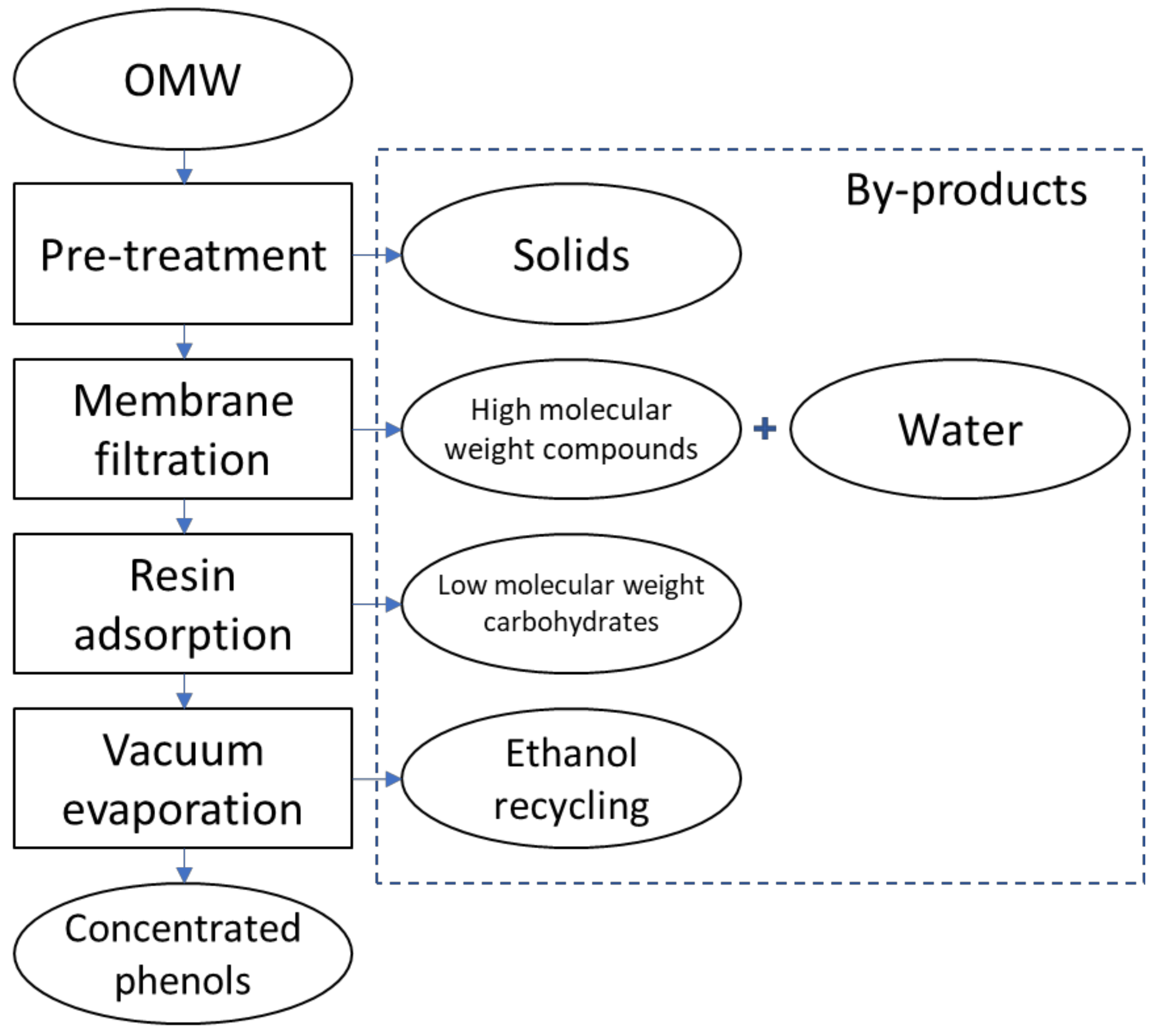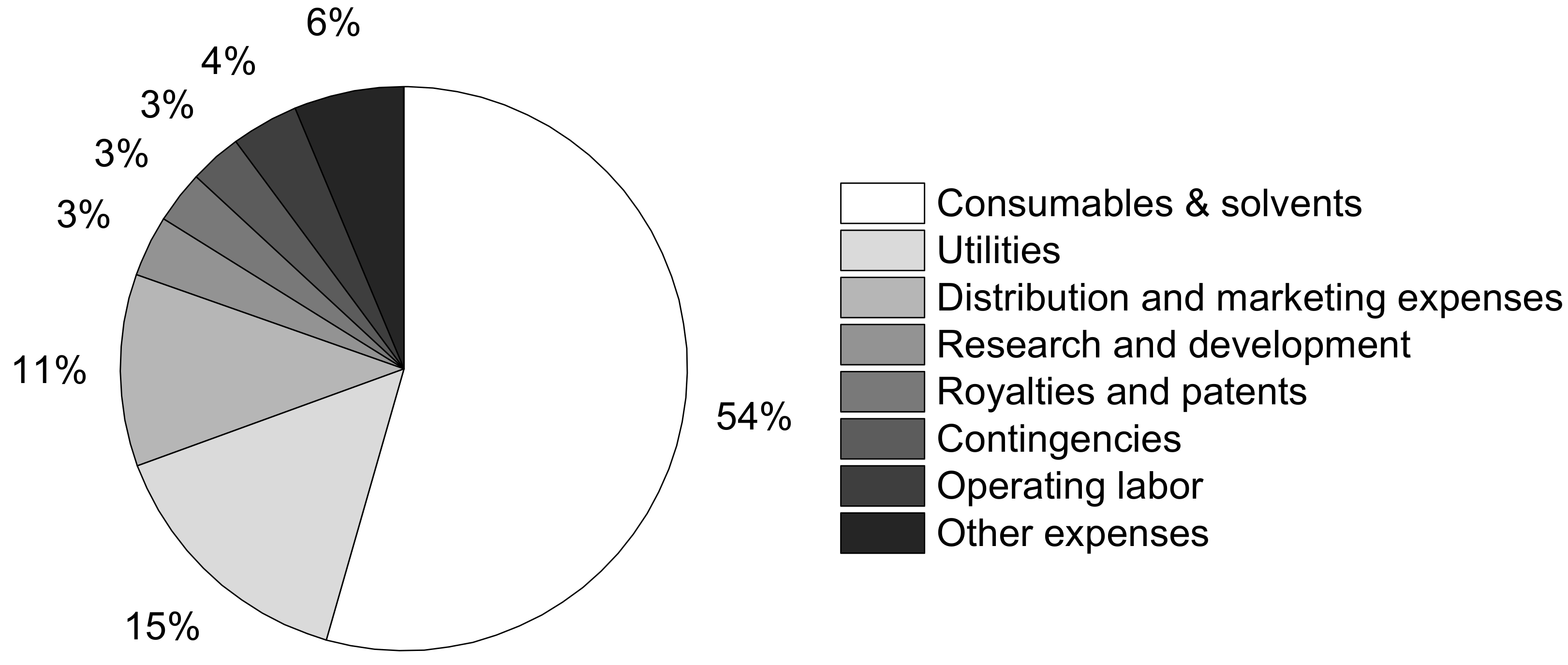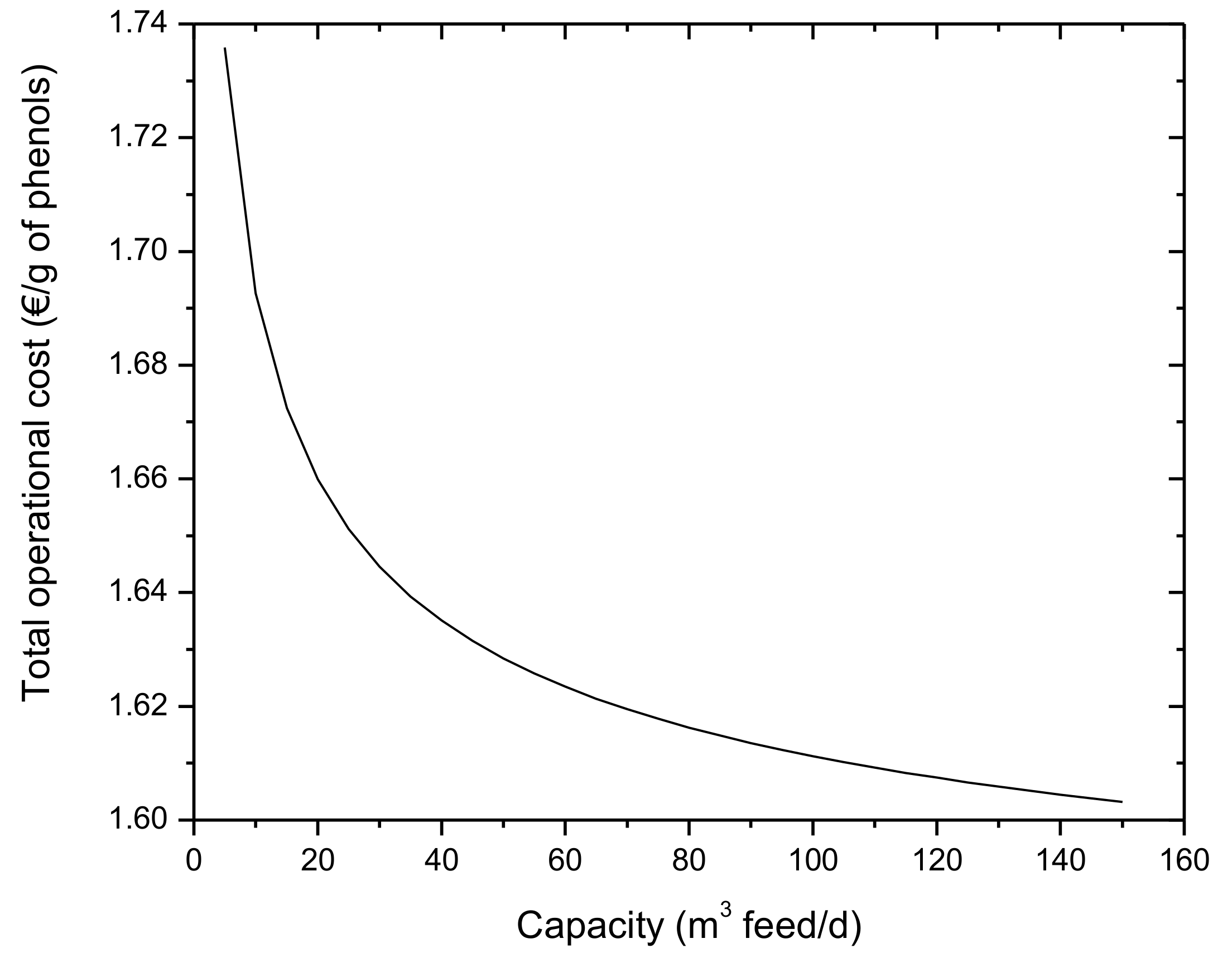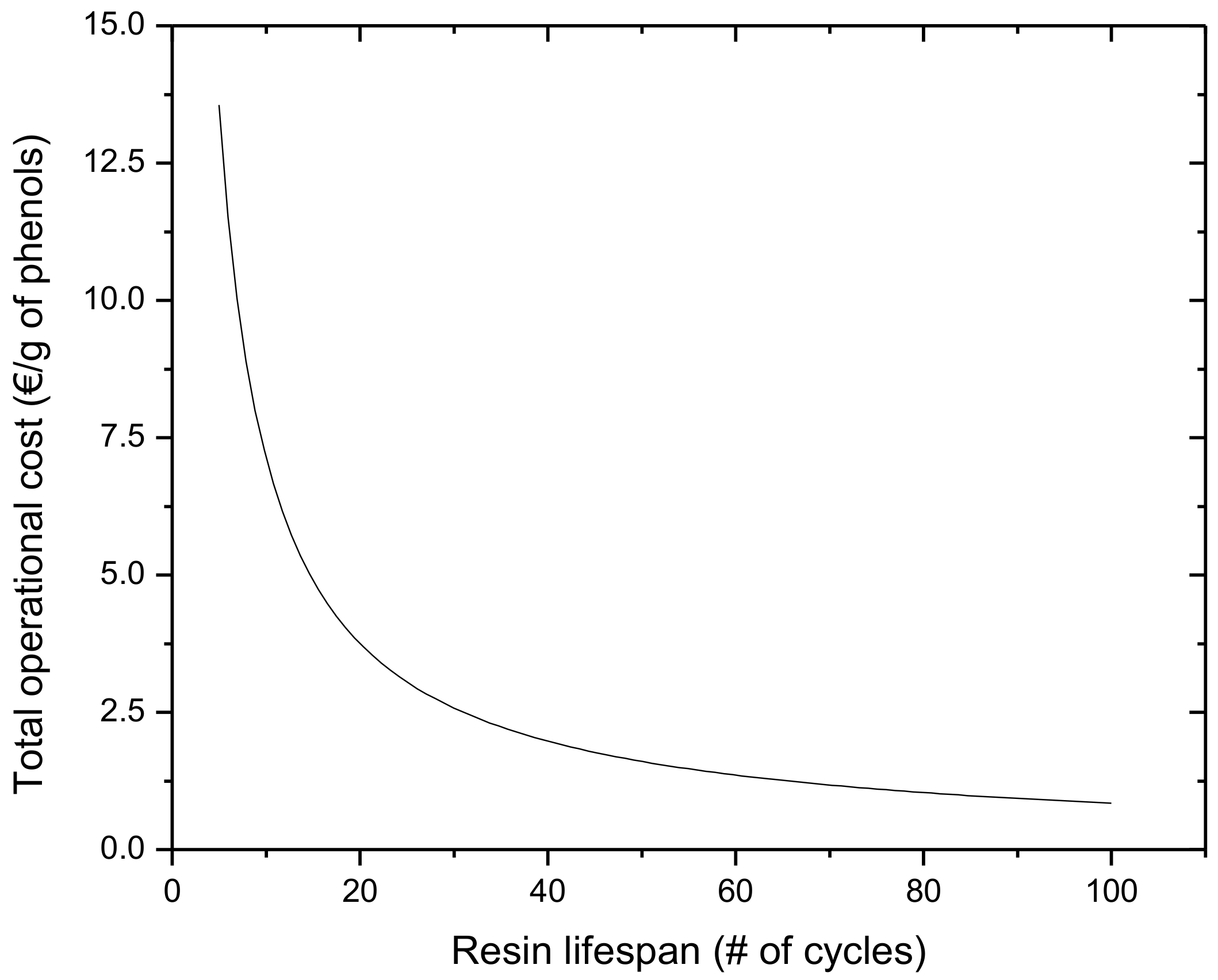Technoeconomic Analysis of the Recovery of Phenols from Olive Mill Wastewater through Membrane Filtration and Resin Adsorption/Desorption
Abstract
1. Introduction
2. Materials and Methods
3. Results
3.1. Purchased Equipment Cost and Fixed Capital Investment
3.2. Total Operational Cost
4. Discussion
5. Conclusions
Author Contributions
Funding
Institutional Review Board Statement
Informed Consent Statement
Data Availability Statement
Conflicts of Interest
References
- Aissa, I.; Kharrat, N.; Aloui, F.; Sellami, M.; Bouaziz, M.; Gargouri, Y. Valorization of antioxidants extracted from olive mill wastewater. Biotechnol. Appl. Biochem. 2017, 64, 579–589. [Google Scholar] [CrossRef]
- Kumar, S.; Abedin, M.M.; Singh, A.K.; Das, S. Role of Phenolic Compounds in Plant-Defensive Mechanisms. In Plant Phenolics in Sustainable Agriculture; Lone, R., Shuab, R., Kamili, A.N., Eds.; Springer Singapore: Singapore, 2020; Volume 1, pp. 517–532. ISBN 978-981-15-4890-1. [Google Scholar]
- Banias, G.; Achillas, C.; Vlachokostas, C.; Moussiopoulos, N.; Stefanou, M. Environmental impacts in the life cycle of olive oil: A literature review. J. Sci. Food Agric. 2017, 97, 1686–1697. [Google Scholar] [CrossRef] [PubMed]
- Espadas-Aldana, G.; Vialle, C.; Belaud, J.-P.; Vaca-Garcia, C.; Sablayrolles, C. Analysis and trends for Life Cycle Assessment of olive oil production. Sustain. Prod. Consum. 2019, 19, 216–230. [Google Scholar] [CrossRef]
- Brenes, M.; Romero, C.; García, A.; Hidalgo, F.J.; Ruiz-Méndez, M.V. Phenolic Compounds in Olive Oils Intended for Refining: Formation of 4-Ethylphenol during Olive Paste Storage. J. Agric. Food Chem. 2004, 52, 8177–8181. [Google Scholar] [CrossRef] [PubMed]
- Hernández, D.; Quinteros-Lama, H.; Tenreiro, C.; Gabriel, D. Assessing Concentration Changes of Odorant Compounds in the Thermal-Mechanical Drying Phase of Sediment-Like Wastes from Olive Oil Extraction. Appl. Sci. 2019, 9, 519. [Google Scholar] [CrossRef]
- Galanakis, C.M. Phenols recovered from olive mill wastewater as additives in meat products. Trends Food Sci. Technol. 2018, 79, 98–105. [Google Scholar] [CrossRef]
- Ciriminna, R.; Meneguzzo, F.; Delisi, R.; Pagliaro, M. Olive biophenols as new antioxidant additives in food and beverage. ChemistrySelect 2017, 2, 1360–1365. [Google Scholar] [CrossRef]
- Galanakis, C.M.; Tsatalas, P.; Galanakis, I.M. Implementation of phenols recovered from olive mill wastewater as UV booster in cosmetics. Ind. Crop. Prod. 2018, 111, 30–37. [Google Scholar] [CrossRef]
- Lavecchia, R.; Zuorro, A. Evaluation of olive pomace as a source of phenolic antioxidants for the production of functional cosmetics. Int. J. Appl. Eng. Res. 2015, 14, 34405–34409. [Google Scholar]
- Gunay, A.; Karadag, D. Recent developments in the anaerobic digestion of olive mill effluents. Process. Biochem. 2015, 50, 1893–1903. [Google Scholar] [CrossRef]
- Khoufi, S.; Louhichi, A.; Sayadi, S. Optimization of anaerobic co-digestion of olive mill wastewater and liquid poultry manure in batch condition and semi-continuous jet-loop reactor. Bioresour. Technol. 2015, 182, 67–74. [Google Scholar] [CrossRef] [PubMed]
- Bouallagui, H.; Rachdi, B.; Gannoun, H.; Hamdi, M. Mesophilic and thermophilic anaerobic co-digestion of abattoir wastewater and fruit and vegetable waste in anaerobic sequencing batch reactors. Biodegradation 2009, 20, 401–409. [Google Scholar] [CrossRef]
- Carlini, M.; Castellucci, S.; Moneti, M. Anaerobic co-digestion of olive-mill solid waste with cattle manure and cattle slurry: Analysis of bio-methane potential. Energy Procedia 2015, 81, 354–367. [Google Scholar] [CrossRef]
- El Gnaoui, Y.; Sounni, F.; Bakraoui, M.; Karouach, F.; Benlemlih, M.; Barz, M.; El Bari, H. Anaerobic co-digestion assessment of olive mill wastewater and food waste: Effect of mixture ratio on methane production and process stability. J. Environ. Chem. Eng. 2020. [Google Scholar] [CrossRef]
- Maragkaki, A.E.; Vasileiadis, I.; Fountoulakis, M.; Kyriakou, A.; Lasaridi, K.; Manios, T. Improving biogas production from anaerobic co-digestion of sewage sludge with a thermal dried mixture of food waste, cheese whey and olive mill wastewater. Waste Manag. 2018, 71, 644–651. [Google Scholar] [CrossRef] [PubMed]
- Alver, A.; Baştürk, E.; Kılıç, A.; Karataş, M. Use of advance oxidation process to improve the biodegradability of olive oil mill effluents. Process. Saf. Environ. Prot. 2015, 98, 319–324. [Google Scholar] [CrossRef]
- Amor, C.; Lucas, M.S.; García, J.; Dominguez, J.R.; De Heredia, J.B.; Peres, J.A. Combined treatment of olive mill wastewater by Fenton’s reagent and anaerobic biological process. J. Environ. Sci. Heal. Part A 2015, 50, 161–168. [Google Scholar] [CrossRef]
- Nogueira, V.; Lopes, I.; Freitas, A.C.; Rocha-Santos, T.A.P.; Gonçalves, F.; Duarte, A.C.; Pereira, R. Biological treatment with fungi of olive mill wastewater pre-treated by photocatalytic oxidation with nanomaterials. Ecotoxicol. Environ. Saf. 2015, 115, 234–242. [Google Scholar] [CrossRef]
- Cuomo, F.; Venditti, F.; Cinelli, G.; Ceglie, A.; Lopez, F. Olive mill wastewater (OMW) phenol compounds degradation by means of a visible light activated titanium dioxide-based photocatalyst. Z. Phys. Chem. 2016, 230, 1269–1280. [Google Scholar] [CrossRef]
- Salameh, W.K.M.B.; Ahmad, H.; Al-Shannag, M. Treatment of olive mill wastewater by electrocoagulation processes and water resources management. Int. J. Environ. Ecol. Eng. 2015, 9, 296–300. [Google Scholar]
- Esfandyari, Y.; Mahdavi, Y.; Seyedsalehi, M.; Hoseini, M.; Safari, G.H.; Ghozikali, M.G.; Kamani, H.; Jaafari, J. Degradation and biodegradability improvement of the olive mill wastewater by peroxi-electrocoagulation/electrooxidation-electroflotation process with bipolar aluminum electrodes. Environ. Sci. Pollut. Res. 2015, 22, 6288–6297. [Google Scholar] [CrossRef]
- Pulido, J.M.O. A review on the use of membrane technology and fouling control for olive mill wastewater treatment. Sci. Total Environ. 2016, 563, 664–675. [Google Scholar] [CrossRef]
- Conidi, C.; Mazzei, R.; Cassano, A.; Giorno, L. Integrated membrane system for the production of phytotherapics from olive mill wastewaters. J. Membr. Sci. 2014, 454, 322–329. [Google Scholar] [CrossRef]
- Gebreyohannes, A.Y.; Mazzei, R.; Giorno, L. Trends and current practices of olive mill wastewater treatment: Application of integrated membrane process and its future perspective. Sep. Purif. Technol. 2016, 162, 45–60. [Google Scholar] [CrossRef]
- Frascari, D.; Bacca, A.E.M.; Zama, F.; Bertin, L.; Fava, F.; Pinelli, D. Olive mill wastewater valorisation through phenolic compounds adsorption in a continuous flow column. Chem. Eng. J. 2016, 283, 293–303. [Google Scholar] [CrossRef]
- Pinelli, D.; Bacca, A.E.M.; Kaushik, A.; Basu, S.; Nocentini, M.; Bertin, L.; Frascari, D. Batch and continuous flow adsorption of phenolic compounds from olive mill wastewater: A comparison between nonionic and ion exchange resins. Int. J. Chem. Eng. 2016, 2016. [Google Scholar] [CrossRef]
- Aliakbarian, B.; Casazza, A.A.; Perego, P. Kinetic and isotherm modelling of the adsorption of phenolic compounds from olive mill wastewater onto activated carbon. Food Technol. Biotechnol. 2015, 53, 207–214. [Google Scholar] [CrossRef] [PubMed]
- Web of Science. Available online: https://www.webofknowledge.com (accessed on 14 December 2020).
- Zagklis, D.P. Separation, Isolation and Enrichment of Phenolic Compounds from Agricultural Byproducts with Physicochemical Methods. Ph.D. Thesis, University of Patras, Patras, Greece, 2015. [Google Scholar]
- Zagklis, D.P.; Paraskeva, C.A. Purification of grape marc phenolic compounds through solvent extraction, membrane filtration and resin adsorption/desorption. Sep. Purif. Technol. 2015, 156. [Google Scholar] [CrossRef]
- Zagklis, D.P.; Paraskeva, C.A. Isolation of organic compounds with high added values from agro-industrial solid wastes. J. Environ. Manag. 2018, 216. [Google Scholar] [CrossRef]
- Zagklis, D.P.; Paraskeva, C.A. Preliminary design of a phenols purification plant. J. Chem. Technol. Biotechnol. 2020. [Google Scholar] [CrossRef]
- Arvaniti, E.C.; Zagklis, D.P.; Papadakis, V.G.; Paraskeva, C.A. High-added value materials production from OMW: A technical and economical optimization. Int. J. Chem. Eng. 2012. [Google Scholar] [CrossRef]
- Zagklis, D.P.; Vavouraki, A.I.; Kornaros, M.E.; Paraskeva, C.A. Purification of olive mill wastewater phenols through membrane filtration and resin adsorption/desorption. J. Hazard. Mater. 2015, 285. [Google Scholar] [CrossRef] [PubMed]
- Peters, M.S.; Timmerhaus, K.D.; West, R.E. Plant Design and Economics for Chemical Engineers, 5th ed.; McGraw-Hill: New York, NY, USA, 2003; Volume 66. [Google Scholar]
- Sid Kalal, H.; Panahi, H.A.; Hoveidi, H.; Taghiof, M.; Menderjani, M.T. Synthesis and application of Amberlite xad-4 functionalized with alizarin red-s for preconcentration and adsorption of rhodium (III). Iran. J. Environ. Health Sci. Eng. 2012, 9, 7. [Google Scholar] [CrossRef] [PubMed]
- Pan, B.; Du, W.; Zhang, W.; Zhang, X.; Zhang, Q.; Pan, B.; Lv, L.; Zhang, Q.; Chen, J. Improved Adsorption of 4-Nitrophenol onto a Novel Hyper-Cross-Linked Polymer. Environ. Sci. Technol. 2007, 41, 5057–5062. [Google Scholar] [CrossRef] [PubMed]
- Frascari, D.; Bacca, A.E.M.; Wardenaar, T.; Oertlé, E.; Pinelli, D. Continuous flow adsorption of phenolic compounds from olive mill wastewater with resin XAD16N: Life cycle assessment, cost–benefit analysis and process optimization. J. Chem. Technol. Biotechnol. 2019, 94, 1968–1981. [Google Scholar] [CrossRef]
- Galanakis, C.M.; Tsatalas, P.; Galanakis, I.M. Phenols from olive mill wastewater and other natural antioxidants as UV filters in sunscreens. Environ. Technol. Innov. 2018, 9, 160–168. [Google Scholar] [CrossRef]
- Fiume, M.M.; Bergfeld, W.F.; Belsito, D.V.; Hill, R.A.; Klaassen, C.D.; Liebler, D.C.; Marks, J.G.; Shank, R.C.; Slaga, T.J.; Snyder, P.W.; et al. Safety Assessment of Vitis vinifera (Grape)-Derived Ingredients as Used in Cosmetics. Int. J. Toxicol. 2014, 33, 48S–83S. [Google Scholar] [CrossRef]






| Fixed Capital Investment [FCI] | Purchased equipment [PE] | Cost a × (Capacity b/Capacity a)0.6 | |
| Direct costs | Piping | 0.65 × PE | |
| Instrumentation and controls | 0.18 × PE | ||
| Electrical equipment and materials | 0.2 × PE | ||
| Buildings | 0.45 × PE | ||
| Yard improvements | 0.15 × PE | ||
| Service facilities | 0.55 × PE | ||
| Land | 0.06 × PE | ||
| Indirect costs | Engineering and supervision | 0.3 × PE | |
| Construction expenses | (PE + Direct costs) × 0.1 | ||
| Contractor’s fee | (PE + Direct costs) × 0.04 | ||
| Contingency | (PE + Direct costs) × 0.08 | ||
| Start-up expense | (PE + FCI) × 0.08 | ||
| Working capital | 0.1 × FCI | ||
| Total capital investment | FCI + start-up expense + working capital | ||
| Total Operational Cost [€/y] [TOC] | Direct production costs | Consumables and solvents | Mass balance of the process |
| Operating labor [OL] | 5000 × capacity in m3/d | ||
| Operating supervision | 0.15 × OL | ||
| Utilities | 0.15 × OL | ||
| Maintenance and repairs [MR] | 0.07 × FCI | ||
| Operating supplies | 0.15 × MR | ||
| Laboratory charges | 0.15 × OL | ||
| Royalties and patents | 0.03 × TOC | ||
| Fixed charges | 0.1 × (PE + Buildings) + 0.02 × FCI | ||
| Plant overhead | 0.6 × OL | ||
| Administrative expenses | 0.25 × OL | ||
| Distribution and marketing expenses | 0.11 × TOC | ||
| Research and development | 0.035 × TOC | ||
| Financing | 0.05 × FCI | ||
| Contingencies | 0.03 × TOC | ||
| Equipment | Capacity | Unit | Amount | Price in €/Piece |
|---|---|---|---|---|
| SS Tank | 3 | m3 | 1 | 2133 |
| 2.5 | m3 | 1 | 1912 | |
| 2 | m3 | 2 | 1673 | |
| 1 | m3 | 13 | 1103 | |
| 0.5 | m3 | 3 | 728 | |
| Agitation | 3 | m3 | 1 | 1100 |
| Flotator | 0.5 | m3/h | 3 | 450 |
| Decanter | 0.5 | m3/h | 3 | 4800 |
| V-separator | 0.5 | m3/h | 3 | 6000 |
| Membrane system | 1.5 | m3/h | 1 | 100,000 |
| Resin housing | 65 | kg | 3 | 650 |
| Evaporator | 0.035 | m3/h | 3 | 5500 |
| Consumable | Amount | Unit | Price | Cost [€/y] |
|---|---|---|---|---|
| UF modules | 1.9 | m2/y | 71.4 €/m2 | 137 |
| NF modules | 7.5 | m2/y | 13.6 €/m2 | 103 |
| RO modules | 10.1 | m2/y | 9.4 €/m2 | 94 |
| Resin | 7118 | kg/y | 319 €/kg | 2,270,483 |
| Ethanol | 57.67 | m3/y | 600 €/m3 | 34,591 |
Publisher’s Note: MDPI stays neutral with regard to jurisdictional claims in published maps and institutional affiliations. |
© 2021 by the authors. Licensee MDPI, Basel, Switzerland. This article is an open access article distributed under the terms and conditions of the Creative Commons Attribution (CC BY) license (http://creativecommons.org/licenses/by/4.0/).
Share and Cite
Zagklis, D.P.; Papageorgiou, C.S.; Paraskeva, C.A. Technoeconomic Analysis of the Recovery of Phenols from Olive Mill Wastewater through Membrane Filtration and Resin Adsorption/Desorption. Sustainability 2021, 13, 2376. https://doi.org/10.3390/su13042376
Zagklis DP, Papageorgiou CS, Paraskeva CA. Technoeconomic Analysis of the Recovery of Phenols from Olive Mill Wastewater through Membrane Filtration and Resin Adsorption/Desorption. Sustainability. 2021; 13(4):2376. https://doi.org/10.3390/su13042376
Chicago/Turabian StyleZagklis, Dimitris P., Costas S. Papageorgiou, and Christakis A. Paraskeva. 2021. "Technoeconomic Analysis of the Recovery of Phenols from Olive Mill Wastewater through Membrane Filtration and Resin Adsorption/Desorption" Sustainability 13, no. 4: 2376. https://doi.org/10.3390/su13042376
APA StyleZagklis, D. P., Papageorgiou, C. S., & Paraskeva, C. A. (2021). Technoeconomic Analysis of the Recovery of Phenols from Olive Mill Wastewater through Membrane Filtration and Resin Adsorption/Desorption. Sustainability, 13(4), 2376. https://doi.org/10.3390/su13042376







